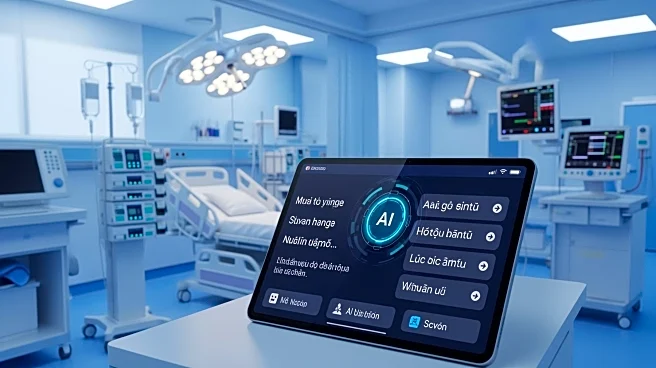What's Happening?
A recent study evaluated the effectiveness of AI-enabled translation tools, specifically ChatGPT-4o, in translating patient discharge instructions across six languages. The study found that while AI translations
were generally effective, they performed variably across different languages, with poorer results for digitally underrepresented languages like Armenian and Somali. The incorporation of a human-in-the-loop approach, where human oversight is integrated into the AI translation process, resulted in improved translation quality, often surpassing professional translations. This approach also significantly reduced the time required for translations, making it a preferred method among evaluators. The study highlights the challenges AI systems face in translating languages with less digital representation and underscores the importance of human involvement to ensure accuracy and safety in clinical settings.
Why It's Important?
The findings of this study have significant implications for the healthcare industry, particularly in improving communication with non-English speaking patients. As AI continues to be integrated into healthcare, ensuring accurate and culturally sensitive translations is crucial to patient safety and care quality. The human-in-the-loop approach not only enhances translation accuracy but also addresses potential safety concerns associated with fully automated systems. This method could lead to more efficient healthcare delivery, reducing the time and resources needed for professional translations. However, the study also highlights the need for ongoing oversight and the involvement of linguists and clinicians to navigate the nuances of different languages and cultural contexts, ensuring equitable healthcare access for all patients.
What's Next?
The study suggests that healthcare institutions may consider adopting hybrid translation workflows that combine AI and human oversight to improve efficiency and maintain high-quality patient communications. As AI technology evolves, further research is needed to develop standardized quality metrics and benchmarking datasets to assess translation performance across various languages. Policymakers and healthcare providers must prioritize the integration of multidisciplinary perspectives, including those of patients and caregivers, to define acceptable clinical workflows and protect patient privacy and safety. The cautious introduction of human-in-the-loop strategies could expand the range of languages and applications for AI translation in healthcare, provided they meet rigorous performance standards.
Beyond the Headlines
The study raises important ethical and cultural considerations in the use of AI for healthcare translations. The disparities in translation quality for underrepresented languages highlight the risk of exacerbating existing healthcare inequalities. Ensuring that AI systems are trained on diverse datasets and include human oversight can mitigate these risks. Additionally, the study emphasizes the need for responsible AI frameworks that engage linguists, clinicians, and patients in the development and implementation of AI technologies, ensuring that they are used safely and equitably in clinical practice.











